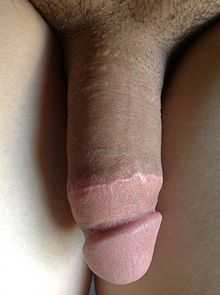Circumcision scar

In males who have been circumcised, the circumcision scar refers to the scar after a circumcision has healed. In some cases, the scar can be darker-colored, and, in all cases, it will encircle the shaft of the penis.
Appearance
The scar, which completely encircles the shaft of the penis, is located at the boundary of the shaft skin and the inner foreskin remnant, which is the portion of the foreskin that was not removed during circumcision. This foreskin remnant is mucosa that lies between the glans and the circumcision scar, which results in dissimilar tissue healing together. In adult circumcision part of the frenulum may remain intact. The foreskin remnant is dried mucosa and can often have a different color and texture than the rest of the penile skin. It can be pinkish or light-colored, and it can be covered with keratin to protect it from a dry environment. Some circumcision scars result in a marked color difference on the shaft.
The type of circumcision scar relies on the technique that was used. Some circumcised men have a prominent or uneven scar, whereas in others it is less noticeable. The appearance of the scar can be reduced through the process of foreskin restoration. A completed restoration normally results in the circumcision scar being completely hidden from view on the inner surface of the regrown prepuce.
Problems with the scar
There is some controversy as to what happens to the severed nerves of the foreskin at the scar. Xin et al. (1997) suggest that nerves regenerate, forming new receptors.[1] However, pathologists Cold & Taylor (1999) report: "Histology of the male circumcision scar shows amputation neuromas, Schwann cell proliferation and the bulbous collection of variably sized neurites. Amputation neuromas do not mediate normal sensation and are notorious for generating pain."[2]
Penile cancer can occur on the scar.[3][4] In some cases, the scar can form a tight constricted ring causing preputial stenosis.
Additional images
-

Distinctive brown ring scar resulting from neonatal circumcision using the Gomco clamp method
-

Errors in circumcision may cause uneven scarring
See also
References
- ↑ Xin ZC, Choi YD, Rha KH, Choi HK. Somatosensory evoked potentials in patients with primary premature ejaculation. J Urol. 1997;158(2):451-7. doi:10.1016/S0022-5347(01)64499-9. PMID 9224321.
- ↑ Cold CJ, Taylor JR. The prepuce. BJU Int. 1999;83 Suppl 1:34-44. doi:10.1046/j.1464-410x.1999.0830s1034.x. PMID 10349413.
- ↑ Bissada NK, Morcos RR, el-Senoussi M. Post-circumcision carcinoma of the penis. I. Clinical aspects. J Urol. 1986;125(2):283-5. PMID 3944860.
- ↑ Fetsch JF, Davis Jr CJ, Miettinen M, Sesterhenn IA. Leiomyosarcoma of the penis: a clinicopathologic study of 14 cases with review of the literature and discussion of the differential diagnosis. Am J Surg Pathol. 2004;28(1):115-25. PMID 14707873.